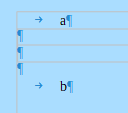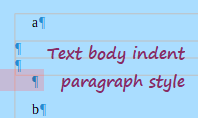If I type a tab before inserting a table, the created table ignores, and in fact, deletes that deliberate whitespace. How am I to force the table to adhere to the indentation?
Tables are not text but you could:
- Right-click the table, select Table Properties and in the Table tab for Alignment select From Left then under Spacing > Left set the same distance as the tab, e.g. 1.27 cm. Or
- Insert a Frame, set it to anchor As Character and put a table inside it. Right click Frame and select Properties, in tab Wrap Set Spacing Left to 0cm.
NOTE this puts the table outside the normal text flow which can cause issues.
Thanks. However, if it’s outside the text flow, that would make such elements problematic after insertion of a few of them, especially when restructuring documents.
I’m quite confident that I have been able to achieve this with Word, so perhaps I’ll try creating a document in that first and then importing it into LO to ascertain whether it does actually support it.
It would work for moving items around in the document.
If you export to PDF the generated Bookmarks for any in the Frame will appear before those in the body of the text, so out expected order.
See Bug 143569 - Headings outside the main body are out of order in Navigator and PDF
Navigator is fixed, TOC still has out-of-correct-order issues ( Bug 95239 - Wrong ToC in Navigator and PDF when using frames), export to pdf still out-of-correct-order in Outline, see
TableInFrame.odt (30.3 KB)
and generated pdf
TableInFrame.pdf (30.4 KB)
[Edit]
Word 2010 doesn’t work the way you describe; the table is inserted the next line after the tab. If I backspace the table then the tab is inserted inside the first cell
Word and Writer are based on different basic principles (otherwise why to have two applications?). In Writer, tables are off-main flow objects which extend by default from margin to margin. They are not located inside a paragraph. Consequently any text can’t be affixed to them as well as positioning directive (a tab is not a “display” character) don’t apply to them, be they taken from styles or direct formatting.
Creating space at left or right requires manual action on the table properties.
Go to the Table tab. Choosing an Alignment other than Automatic allows you to define a width different from the margin distance. Then, you can set a left or right spacing under the constraint that table_width + left_spacing + right_spacing = margin_distance.
Just head the first advice of EarnestAl. Right-clicking the table will seamlessly allow you to move it to the right. Inserting tabs is something we used to do on a Triumph typewriter.
To provide an open-source alternative that’s hopefully superior to its proprietary counterpart. I’m discussing interpretation of ISO standardized XML document formats. This isn’t a philosophical discussion.
I’ve only tested this with the Microsoft 365 / 2022 version, and again, I’m uncertain of whether I recall correctly. Thanks though.
I just tried in Word 2010 again but with Indent then Insert Table and it does as you say, also for Google Docs.
You could create an enhancement request for LO Writer, How to Report Bugs in LibreOffice - The Document Foundation Wiki
No.

The table is just inserted in a new paragraph.

Writer will not pass the initial tab as an indent order/command for the next paragraph.
Notwithstanding, the new paragraph added with a table (not the table itself) will retain the indent of the original paragraph.

Your discussion has nothing to do with interpretation of any file format. It is about run-time UI decisions that an application does to convert user input into some kind of document. In both cases, the end result will be saved into some kind of standard-compliant file format, but this is unrelated to how the existing paragraph indentation affects properties of newly created tables.
@mikekaganski, your comment appears to contradict itself:
Your discussion has nothing to do with interpretation of any file format.
It is about run-time UI decisions that an application does to convert user input into some kind of document.
Additionally, if the table is interpreted differently in different software, that is fundamentally incompatibility. Formatting is content as much as text is.
I’ll be glad for any clarification.
your comment appears to contradict itself
Absolutely not. Document model in memory is not a file format. You describe how the prior indent is considered or not when a table is created, but this is not defined in any file format; the file formats define how (in which 1s and 0s) the resulting table must be represented on disk - and both the tables with and without indents can be stored in the “ISO standardized XML document formats”.
Additionally, if the table is interpreted differently in different software, that is fundamentally incompatibility
No. Incompatibility is inability to open the files created in other software correctly. While there indeed is incompatibility in LO vs. MS Office, because they use fundamentally different document models, this topic has nothing to do with it: when you create a table in your described procedure on Word, and save to a file, and open in LO, it will be opened in Writer with the proper indent - so Writer can read this stored result correctly; and when you use your procedure in Writer (so the table has no indent), the file saved from Writer will open OK (also without indent, i.e. the same as in the generating application) in Word.
